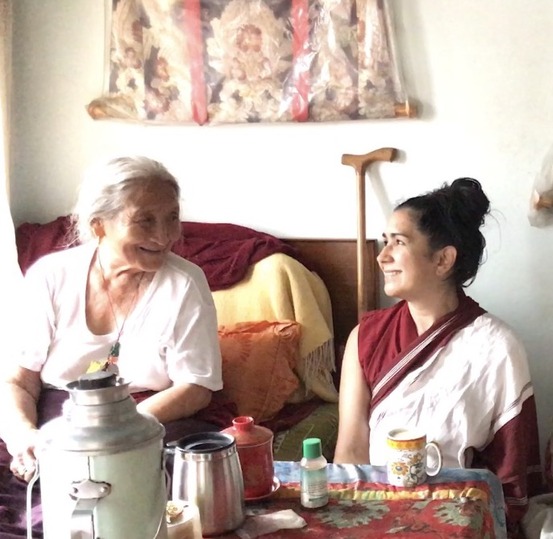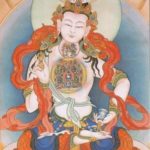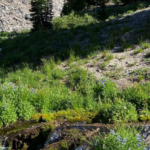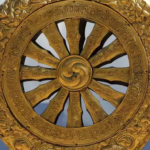A Little Story About Nepal and Advice for How to Prepare for Retreat
I remember one time when I was visiting with the great Tibetan yogini, Jomo Samphel Dechen in Nepal. I had just wandered over to her apartment, and she was there about to take tea. Her legs were having problems so she needed help to get back and forth to get the kitchen. In Kathmandu it was very hot and sticky, but the kitchen was really cool. And I realized, during our slow walk from the kitchen back to her sitting room that I could ask her anything. No one was in sight, and I was slowly getting used to her accent, hard for me at first, because I was trained in Lhasa-dialect Tibetan. So with no one around and at least a fifty percent chance of understanding her answers, I quickly assembled my thoughts about what I would like to ask, how best to use this marvelous precious time. So many possible questions – dharma practice as a woman, dharma practice after her spouse had died. I had all these scholarly interests at hand, and as usual, they were there creating my inner fireworks of fascinations and curiosities. Plus, because I had previously always visited with others, I had already asked her so much in more formal meetings with other people. So there was this space, this wide open room to ask the deeper questions in private. We had our tea and then it was time. But instead, a few hours later I realized I just got lost in the moments. I totally missed the opportunity as a historian of Buddhism to dig in, because we just sat there quietly and delightfully together doing recitations, visualizations, chatting, reciting mantras and then again having tea. She started reading from a prayer from a pecha text, a Tibetan scripture. These are the long, narrow papers with wood block printing on them. I read along. And then we had these long periods of pleasing silence and then the prayers again and more tea. That’s when I remembered (yet again) how it is really, really wonderful to do dharma practice. It is especially wonderful to do dharma practice with someone so experienced, so integrated with the aesthetics of contemplation as the core of their life. We sat in the richness of all the practices either of us had ever done and in the stark simplicity of just being human together. It is hard to describe that experience, but words do come to mind: grounded, firm, present, soft, gentle, joyful, serene, focused. And yet, the chaos of Kathmandu was not too far away, somehow still looming, but without any sense of invading our serenity.

Jomo Samphel Dechen and Pema Khandro Kathmandu 2017
This is how all things in India, Tibet and Nepal have tended to be for me. Not what I expect, impossible to control, but offering something potent. (It is easier to live in Asia if one is comfortable letting go of control.) Through these travels I found out, surprisingly, that really deep dharma practice can happen in all kinds of scenarios. Just after tea on a visit to a great yogini. At sunrise at a stupa. In a huge crowd of Troma Chod yogis and yoginis, with our long hair and red and white shawls coloring the landscape. While being assailed by mosquitos in India. By rivers and meadows in Tibet. While stuck on a remote road and eventually surrounded by giant scary yaks in Kham (If a yak steps on my legs, what will happen? And other thoughts…but they simply walked around me). When the King was murdered and there was a coup in Kathmandu, but there was the strange persistent beauty of a garden to practice in. At ground zero after 9/11. And pleasant, protected practice retreats in a nice hotel in China or Mexico. The scenes of dharma practice may change, but the sense of being centered, sane and simple has not. I try to think of words to describe this since I teach classes and words are necessary. I look for kitchen sink words, not pie in sky ones, that would fuel spiritual fantasies (or colonialist ones!). Words do come to mind: integrated, present, serene, wakeful.
The obstacles to practice can also be what one does not expect. I remember when I had pneumonia, practicing Chod at the charnel grounds, a kind of funerary meditation, and the deceased was being cremated before us. It was a perfect place to practice Chod, but my pneumonia wanted me home. Afterall, how many charnel grounds should one visit before it is time to take a break to take care of the body again?! And yet, that night after the practice, I had these wonderful dreams, and it shifted my whole thinking about what was next in my life. I think of that dream often. Even that practice, quite half-hearted in my haze of illness while the other half just tried to keep me alive, even that practice had an interesting result.
I think its this background of shifting scenes of practice, that prepared me for the transition online. We had been preparing to launch the Buddhist Studies Institute already for many months, so online activities were already set to increase. Then the pandemic happened. Suddenly, everyone I knew (and new friends I came to know) was there with me in my home, practicing with me online. It has been such a luxury to find this way of practicing Vajrayana together and to discover that this can be so profound. There I am, on my meditation cushion and my meditation rug. No being assailed by mosquitos, not bit by scorpions, snakes, nor assailed by the smell of burning corpses or locals dressed like police trying to hassle a foreign woman, none of those obstacles that are such a hallmark of living in Asia! No visa issues looming, no smell of burning plastic outside my window like in Pharping. Just the lovely space at Khandro Ling, a peaceful place I set up just to do practice each day, but now, there are a hundred dharma friends who are there with me, in my most personal space. And I am in their home with them.
We get to do what is the ultimate goal of our tradition as yogis, (naljormas, naljorpas, ngakpas, ngakmos) is – which is to integrate deep serious practice and study with our actual lives. To transform our home into the domain of real spiritual work. A surprising gift of zoom society. We don’t have the luxury of living in a monastery or cave. We are integrating practice and study with the complexities of modern life. Instead of scorpions, the sound of children. Instead of visa troubles, the pets need to be fed. Instead of pilgrimage sites, our own bodies. We are practicing where the rubber meets the road, where the whole of our life is present with us.
Throughout the pandemic we have been doing this together. We are practicing alone, on our own, as we must do, but simultaneously together. We are in our own ideal or non-ideal environments. There is something incredibly intimate about practicing this way. So hard to describe. But words do come to mind: integrated, wakeful, open-hearted, sane, deep, connected, expansive.
There is something also so honest about it, practicing at home together.
I am supposed to be writing about preparing for a home retreat, so we should get back to the tea and the tale of my time with Jomo Samphel Dechen. That afternoon, on my way walking home from the visit, I was reflecting on what actually makes a perfect place for meditation practice. We were in her home, a humble space, put together with minimum expenditures. Yet it was an ideal space for a home retreat. She had surrounded herself with Buddhist images, there was a small shrine. There was a window so the sky and space were present ever so simply. There was tea and cookies so that we could take as long as we needed. There was a little table for texts to rest on. There were pictures of inspiring figures, including her deceased spouse, the famous tsa-lung yogi, Kunzang Dorje Rinpoche. There was a blanket for when it was cold, but it could be shed when it was warm. There were nice cushions to sit on for the guest and a bed for her, so our bodies were supported. Just like my place for practice at Khandro Ling in Virginia, 7,708 miles away. Simple, practical, intimate. In light of this cherished memory of a perfect place to practice at home, I have included some tips on setting up a home retreat space for you below.
But before closing, we should contemplate bell hooks.
“I want there to be a place in the world where people can engage in one another’s differences in a way that is redemptive, full of hope and possibility. Not this ‘In order to love you, I must make you something else’. That’s what domination is all about, that in order to be close to you, I must possess you, remake and recast you.”
― bell hooks, Reel to Real: Race, Sex, and Class at the Movies
Practicing in Times of Intensity
I love this quote from bell hooks. I have been reading her today to help prepare and process the energy of the verdict. The quote reminds me of Dzogchen in the sense that our freedom is only possible if we make friends with what we are. Until we do, we are so lost and exploitable.
Fascinating that last year we had retreats together during protests, when the heart-wrenching George Floyd video had just been released. Now we will practice just after the guilty verdict in the trial of his murder. So we happen to meet again in a charnel grounds, in the middle of sea change in consciousness…Moving ever so step by step towards a world with empathy and respect for the dignity of beings. There is hope, but even with accountability, which was so desperately needed, there is also grief. There has been no closure in the grief about racism. There is still so much grief from all the wounds that have been scratched open. There is the continuously refreshed grief as we face the horrors of stories like Adam Toledo, a thirteen year old boy killed by police. Grief, empathy, anxiety, sorrow, a tidal wave of emotions is understandable – and we bare these while being so isolated from one another during the pandemic. There is no one right way to grieve. Some of us get angry, others withdrawn, others reach for connection, the sadness, the depression or numbness. It is part of a greater process of waking up and healing individually and collectively.
My article on grief in Lion’s Roar is here: Pema Khandro on Grief.
We can bring all this with us to our practice, carrying it on to the path as we learn to find a sane, open-hearted way to meet the whole of this life as it is. It is another scene, another charnel grounds another moment to train.
May we face what comes together, one breath at a time, one session at a time, one day at a time.
I look forward to seeing you at the online retreat in a couple of days.
Yours always,
Pema Khandro
![]()
How To Set Up A Place To Practice
Home Retreat Preparation Details
Finding Comfort and Ease with Pema Khandro
April 23-25, 2021, 10am-6pm PT
There is something so intimate about one’s practice spot, the home shrine or meditation cushion. We can have some unique things there that make it a place of comfort and support in our lives. Mine has photos of my teachers and the beings I visualize in my refuge field. It has my glasses and a book light (I learned the brilliance of a good book light from the Zen practitioners!) As you set up for this weekend’s retreat, I recommend that if possible, you set up a place that will be yours beyond this retreat, that it will be a place you can care for your body and mind every day. It doesn’t have to cost a lot of money. In leaner times, I used to just use a tent in the yard outside my cabin at our first retreat center in Santa Cruz, because the temple was still a space for everyone. I needed a solitary sacred place to work within the powers of my introversion. That’s why I was so happy when someone at the summer retreat did the whole retreat in a tent in their backyard, a reminder of happy memories. I have also seen lovely retreat spaces made out of a closet. Or for those who are so lucky a shrine room or small temple. In a small house a closet may be the only way to create a place for solitude, and with some imagination that can be quite lovely. Even that darkness there can help to make it space to deescalate, to reduce the over stimulation of daily life.
Whatever place you set up, may it be an opportunity to establish a sacred place that you can return to, with body and mind.
Our retreat will be from Friday to Sunday, April 23rd-25th.
The lung, or oral transmission, will happen on Friday morning, which is the traditional pre-requisite to practice.
You will need your texts for the Heart Sutra, which if you don’t have it, it will be provided.
We will study two great works of Dzogchen nyingthig, Longchenpa’s Finding Comfort and Ease and the Mirror Illuminating Heart. I will share my translations.
We will do the practices from Finding Comfort and Ease.
On the last day we will do protector practice so please have your drums, bells and text if you have them. Text will be provided if you need it.
The afternoon community tea times are optional, but highly recommended. It is necessary to know and talk to other meditators. Otherwise, a life of training the body-mind is very hard to maintain without communal support.
We will also have the restorative yoga sessions with some of the brilliant teachers whom I have trained to teach yoga and have carried this practice on for our community.
Remember, you will also have the opportunity to sign up for private meetings one-to-one. The best way to use that time is to bring dharma questions or practice questions, but we can also just have a simple chat as well.
Plan to have your camera on for all the practice sessions. Wear comfortable, loose fitting clothing for sitting and yoga. If you have a shawl or blanket you may wish to have it nearby. Thank you for being fully clothed so that we can all be comfortable! Not everyone lives near a beach town and it can be distracting to see dharma friends in various states of minimum dress, so we ask you to avoid wearing anything revealing.
If you are new, you are most welcome. Diversity is beautiful and the teaching assistants are there to answer questions.






.jpg)